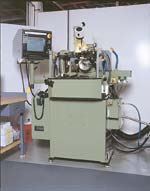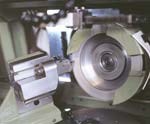Toolmaker Boosts Productivity With Grinder
Given the vitality of the auto market and the growing trend towards aluminum as a weight-saving aid, the demand for this manufacturer's tools has been consistently strong. More than half of the business is regrinding existing tools for customers, with the short lead times necessary to minimize the customer's investment in expensive tooling.
Share









Simon Ellis Superabrasives, Inc. (Dayton, Ohio) is a small but rapidly growing toolmaking company that began almost 10 years ago producing a wide variety of tools for cutting difficult-to-machine metals. The majority of the company's PCD tooling customers are involved in machining high silicon aluminum parts that are used primarily in automotive transmissions and engines. Given the vitality of the auto market and the growing trend towards aluminum as a weight-saving aid, the demand for Simon Ellis' tools has been consistently strong. More than half of the business is regrinding existing tools for customers, with the short lead times necessary to minimize the customer's investment in expensive tooling.
Just as for most businesses, the availability and quality of labor is a critical issue at Simon Ellis. The ten-person shop was running 31 manual tool grinders that were limited by the availability of qualified operators. Each machine needed one operator, and the production of these machines depended on qualified employees being there to run them. Hiring more operators was not really an option, since it is extremely difficult to find qualified toolmakers, and training a novice to run a manual grinder takes about a year. With this rate of turnover, a risky situation emerged for the company.
One machine to one operator: it was in this environment that Simon Ellis decided to buy a Coborn RG6 CNC automatic tool grinder in August 2000 through Precision International, the Bloomfield, Connecticut, agent for Coborn, which is a British manufacturer. The motive behind the purchase was a perceived need to switch to CNC grinding. And, the move to computerized control has had some dramatic results. Because all the functions are inherent in the programming, the RG6 allows a single operator to run three machines. In effect, the company's productivity tripled overnight with the purchase of this machine.
"The single Coborn could probably replace half our manual grinding machines," says Dave Rawson, president. "The actual grinding of the tool is the shortest part of the cycle, but there's no question that our Coborn RG6 led to some dramatic reductions in grinding time. The cycle time improvement on many tools is on the order of 50 to 65 percent.
"It turns out that the majority of our cycle time grinding PCD inserts is attributable to gaging of the tool and compensating for wheel wear. The ability to compensate within each programming block, and the machine's ability to rapidly (in several seconds) measure the tool and regrind as necessary, has had a tremendous impact on our production capacity," says Mr. Rawson.
Machine setup was also a major issue for the shop. Either the operator had to sort orders by type of tool and run batches, which increased the lead time for most customers, or spend a large portion of production time setting up the machines. "It may take us an hour or more to set up a manual machine within the tolerances we require, while the RG6 takes 5 to 15 minutes for setup," Mr. Rawson says.
The Coborn RG6's vision system was the shop's "must have" option, and it is the feature that has most enhanced the productivity of the shop. On the manual machines, operators would spend more than half their time removing the tools from the machines to check size and edge finish. The older manual machines with the built-in 20× optical comparator were simply not sufficient for the tolerances the shop had to meet. The RG6 machine is equipped with Closed Circuit Television (CCTV) monitoring, which uses a 50× video measuring system. "This is really an essential option," Mr. Rawson says. "When we are holding tolerances to within a couple of ten thousandths of an inch, removing the part to check size can introduce locating errors, which can create very expensive scrap."
Accuracy and consistent productivity without extensive operator training were the objectives the company hoped to achieve with its investment in a CNC machine. It took as long as a year for an operator to become fully qualified to produce the high quality, tight tolerance CBN and PCD tooling customers required when the shop was relying exclusively on manual machines. The Coborn RG6 has changed all that. Once the initial programming is done for a given tool, training an operator to run consistently good parts is a process that takes a few days to a few weeks, depending on the machining background of the operator. "Being able to hire an operator and, in a couple of weeks time, have him or her be fully productive is a tremendous competitive advantage in today's tight labor markets," Mr. Rawson says.
"In our business, labor has been the limiting factor on productivity for some time," Mr. Rawson explains. Where many firms spend large sums finding new business, this company was often in the uncomfortable position of deciding whether it could take on new business and still provide the level of service its customers had come to expect.
"The Coborn RG6 has virtually revolutionized our shop," Mr. Rawson says. "When you improve your productivity, reduce your dependence on highly skilled labor and increase your production capacity while maintaining or improving the quality of your product, there's no better way to ensure the long term success of your business."
Related Content
High RPM Spindles: 5 Advantages for 5-axis CNC Machines
Explore five crucial ways equipping 5-axis CNC machines with Air Turbine Spindles® can achieve the speeds necessary to overcome manufacturing challenges.
Read MoreHow to Determine the Currently Active Work Offset Number
Determining the currently active work offset number is practical when the program zero point is changing between workpieces in a production run.
Read MoreQuick-Change Tool Heads Reduce Setup on Swiss-Type Turning Centers
This new quick-change tooling system enables shops to get more production from their Swiss turning centers through reduced tool setup time and matches the performance of a solid tool.
Read MoreLean Approach to Automated Machine Tending Delivers Quicker Paths to Success
Almost any shop can automate at least some of its production, even in low-volume, high-mix applications. The key to getting started is finding the simplest solutions that fit your requirements. It helps to work with an automation partner that understands your needs.
Read MoreRead Next
5 Rules of Thumb for Buying CNC Machine Tools
Use these tips to carefully plan your machine tool purchases and to avoid regretting your decision later.
Read MoreSetting Up the Building Blocks for a Digital Factory
Woodward Inc. spent over a year developing an API to connect machines to its digital factory. Caron Engineering’s MiConnect has cut most of this process while also granting the shop greater access to machine information.
Read MoreBuilding Out a Foundation for Student Machinists
Autodesk and Haas have teamed up to produce an introductory course for students that covers the basics of CAD, CAM and CNC while providing them with a portfolio part.
Read More


.png;maxWidth=150)




























.jpg;maxWidth=300;quality=90)













